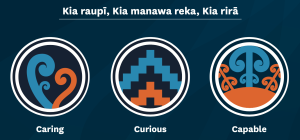Expectations for Behaviour at Ararira
Ararira is a wonderful place to learn and we guide our learners’ behaviour with clear expectations that are linked to our values of being caring, curious and capable. These are short, sharp and memorable and might be good to refer to at home as well.


Caring is our first value supported by aroha and manaakitanga. In essence, this is about behaving kindly.
Being curious requires us to keep an open mind, not jump to conclusions or make assumptions about people’s behaviour and actions and to expect the best. We support curiosity by promoting kaitiakitanga and auahatanga (creativity).


Behaving capably is closely linked to integrity and it is doing the right thing, even when no one is watching. We will encourage children to reflect on their actions and consider how they stack up against these values and precepts. Capability is also fostered through developing an understanding of rangatiratanga (managing self) and kotahitanga (working with others).
More detailed information about behaviour can be found in this parent information post.
School-Wide Systems
During break times we have four teachers out on Connect. They rove and connect with learners and have conversations to support behaviour or redirect when necessary. If there is an incident in the playground a behaviour slip is filled out and left for one of the senior leadership team to consider for follow-up. Data from these incidents is recorded in case patterns emerge. If an incident needs follow up then a teacher visits the class and talks to the child concerned. There is a range of consequences that are dependent on the type of behaviour. Sometimes parents will be informed, this is usually if there has been a pattern or if the incident is more serious. For most children conversations based around our mantra of mess up, fess up, fix up and move on are enough.

Sometimes a deeper conversation is required and all staff have had training in the use of these tools. However, more serious incidents are left to the leadership team to unpack as there may still be a lot of emotion and it is important to wait until everyone is calm. These conversations follow the format of;
- Tell the story – What happened? What were you thinking when doing that?
- Explore the harm – Who has been affected by this behaviour? In what ways? How has your behaviour affected learning today? How fair is this on others?
- Repair the harm – How can you go about fixing this? What exactly are you sorry for? How will this support others’ learning? How will it support your learning?
- Reach an agreement – What do you need to do from now on? How can we support you to do this?
- Plan follow-up – When would be a good time to check in with you to see if you’re doing what we agreed? What support do you need to make sure this doesn’t happen again?
However, for some children when behaviour is more serious or repeated follow-up is required. If the behaviour was serious enough to be deemed gross misconduct or continual disobedience that needed to be addressed, then we can stand down, suspend or ultimately exclude a child. These measures involve the Ministry of Education and are not used very often.

Recent Comments